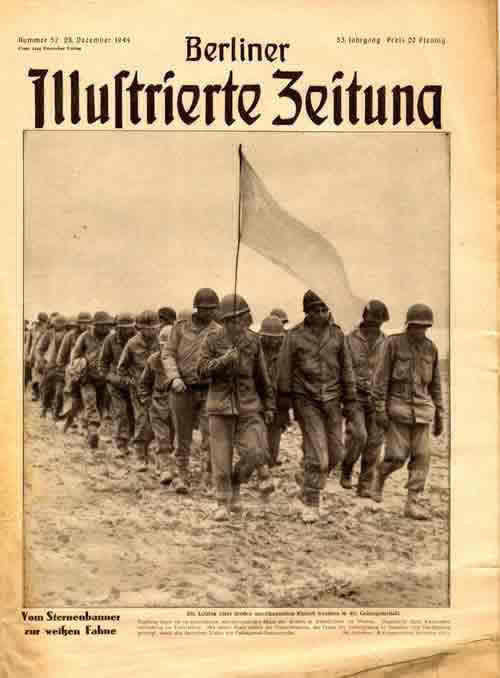|
http://en.wikipedia.org/wiki/Stalag_III-A |
|
Prisoners of the 106th Infantry Division Marching to Stalag III-A. Allied prisoners surrender and march to Stalag III-A. Source is Leo Finegold. This image is copyrighted. The copyright holder allows anyone to use it for any purpose. Stalag III-AFrom Wikipedia, the free encyclopediaStalag III-A was a Nazi POW camp, opened September 1939. By April 1945 had witnessed the death of five thousand interns due to starvation and disease. At its height the compound housed around four thousand American prisoners of war, with separate compounds for thousands of Soviet prisoners, as well as those of Italian, Belgian, English, and French. According to www.dpe.de there were also four thousand prisoners of color. Stalag III-A is one of many prisoner of war camps notorious for their inhumane treatment of prisoners, causing the deaths of thousands. Indeed, many of the prisoners lived solely off parcels delivered by the Red Cross, and drank fresh water sources from only two faucets available for the entire camp. In short, Stalag III-A portrayed the horror of many prisoners of war in camps throughout Germany. The camp was liberated in April 1945 by the Red Army. There are several stories which relate to Stalag III-A, including one provided by Italian prisoner 'Michele Zotta, born in Florenza. He relates the fact that for the first few days of his stay he slept on the floor, regardless of the size of the tent he was moved into. He later states that on his first day he received one kilogram of rye bread to split between fifteen separate prisoners, with some butter and jelly. He says that the daily routine was for the Germans to distribute one blanket per twenty-five prisoners and then pour one bucket of potatoes, to split between two twenty-five prisoners. This account illustrates the poor effort the Germans gave in feeding their prisoners, and Michele Zotta also makes notes that when prisoners collapsed the Germans would beat them. One of the most famous prisoners of Stalag III-A is Duncan Black, a bomber navigator shot down over Düsseldorf in 1943. He was one of the masterminds behind the escape from Stalag III-A, and is known as the 'forger of Stalag III-A', as he was one of the principal individuals responsible for forging documents. He was immortalized on the silver screen as Donald Pleasence, but unlike the movie tells, Mr. Black did not go blind through his efforts, and he did not escape from Stalag III-A, instead staying behind. Through his abilities over four hundred documents were forged, hundreds of compasses were made and hundreds of prisoner clothing was converted to look into convincing civilian garb. The Great Escape, as immortalized in the movie, involved six hundred British and American prisoners of war and was done through a three hundred and thirty foot tunnel leading from a under a stove in Hut 104. In the end, however, only seventy-six prisoners made it through, although seventy-three were later caught, and fifty were executed thereafter on orders from Hitler. Duncan Black died at the age of seventy-three in home at Edinburgh. However, there are also accounts that the Germans were low on food themselves, which seems to give some explanation for the fact that the prisoners of war were treated horrendously. There are examples in which German soldiers would simply change posts in order to be able to receive food to eat, and it is very likely that Hitler and his administration failed to feed the Stalag camps with enough supplies to survive, seeing the front as the more important staging center for his war. Regardless, Stalag III-A remains the epitome of poor conduct on the part of the Germans with prisoners of war. Unfortunately, there is no easy access to accounts of Soviet prisoners but there is no doubt that they were treated worse than the rest, understanding usual German treatment of the Soviets throughout the war. The American prisoners in fact were moved prior to the escape and did not effectively contribute. Australian prisoners made a contribution often overlooked today. The prisoners noted in the 'Great Escape' were airmen of the allied nations and would be interned in a Stalag Luft camp administered by the Luftwaffe (German Air Force). The immense work undertaken was spread among hundreds of prisoners in a camp housing thousands unlike the movie portrayed. Today a tourist can view the site of the escape and walk the tunnels original location at the believed site. although heavily forested now, the site is easily accessible to the public. Jim,
I make the date to be December 1944.The large narrative says: "From Flag with Stars to White Flag" or "From U.S. flag to Flag of Surrender". Cannot read small print below.
Jorg
|


